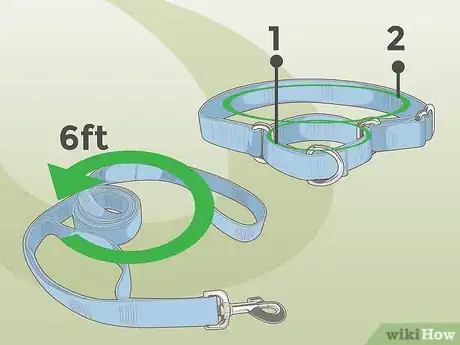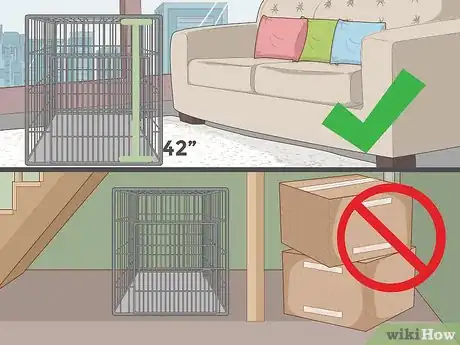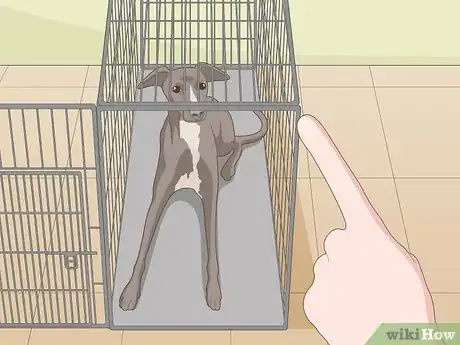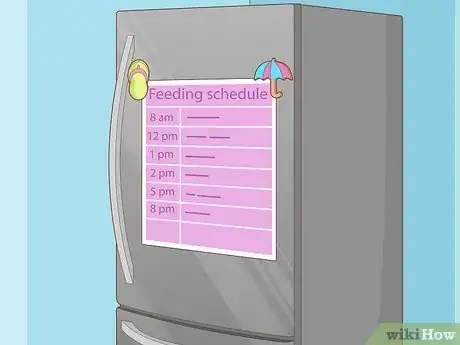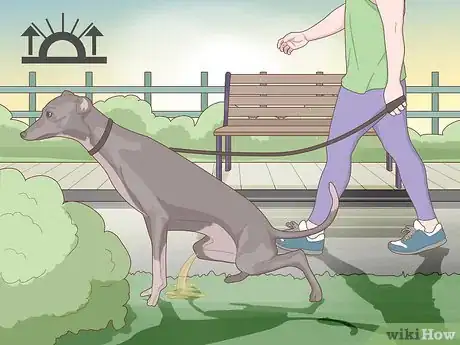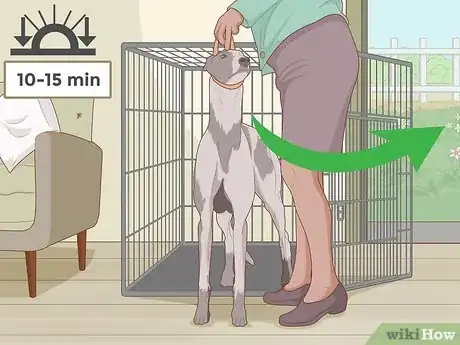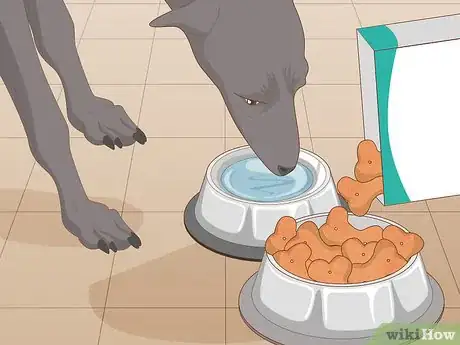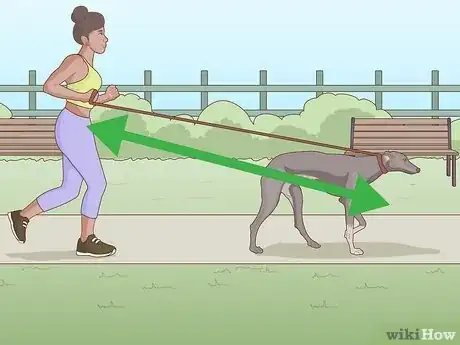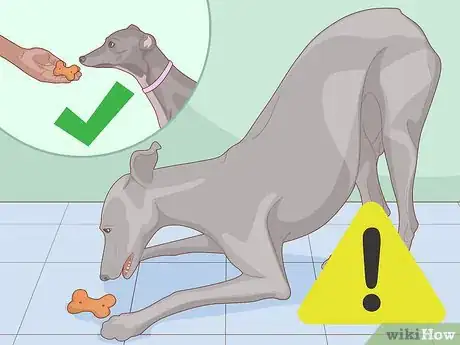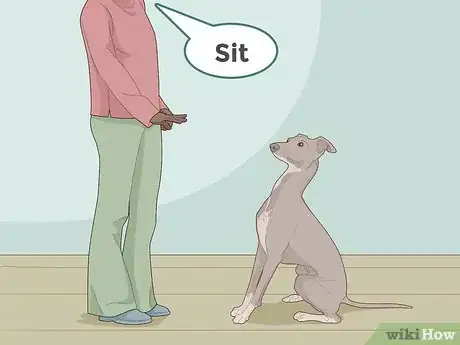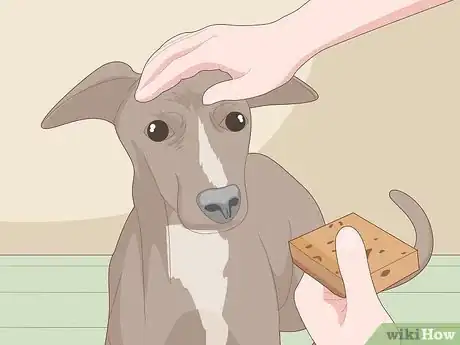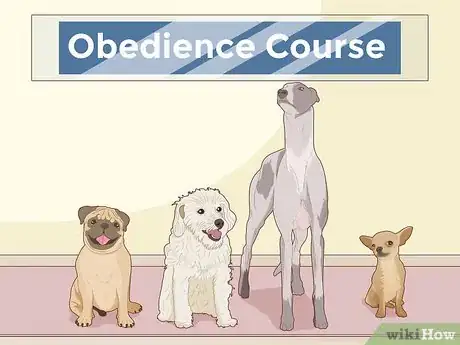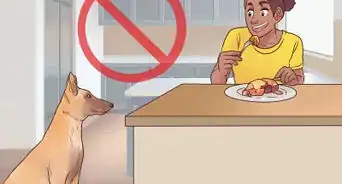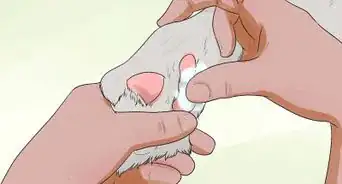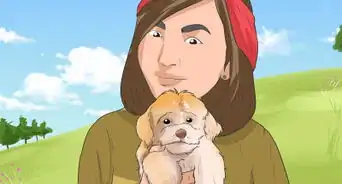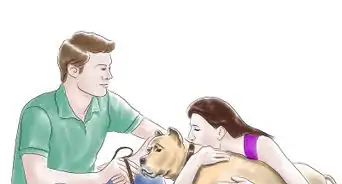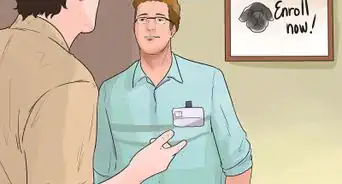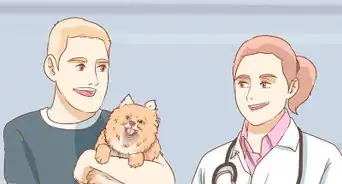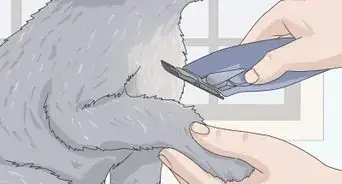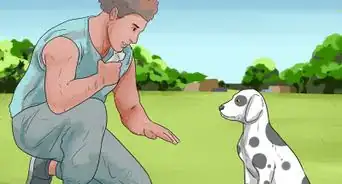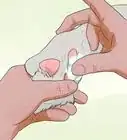This article was co-authored by Ty Brown. Ty Brown is a Dog Behaviorist and Trainer and the Owner of Ty the Dog Guy, a business that provides dog training through digital resources (podcasts, web series, and online courses) along with in-person dog training. Ty has over 17 years of experience in dog training and specializes in both mitigating unruly pet behavior and service dog training. Ty has been awarded the "Best of State Award" for dog training in Utah ten times and his work has been featured in ABC, NBC, CBS, Spike TV, and Entrepreneur Magazine.
This article has been viewed 80,879 times.
Greyhounds are an elegant and popular breed known for their gentle and affectionate nature. Many Greyhounds are rescued from racing tracks or adopted once they retire from racing. Other Greyhounds are bought from a breeder as puppies. Whether you are training a rescued Greyhound or a Greyhound puppy, the essential requirements are the same: patience, consistency, and love.
Steps
House Training Your Greyhound
-
1Buy a 6 feet (1.8 m) nylon leash and a martingale collar. A Greyhound can back out of a standard buckle collar, so you will need to purchase a martingale collar for your new pup. You should never use a metal choke collar as this could damage your Greyhound’s throat.
- You can find the leash and the martingale collar at your local pet store. A martingale collar is made up of 2 loops, a large loop that is adjustable and placed around your dog's neck, and a small loop, known as the control loop. The leash is clipped to the D ring on the small loop. When your dog tries to pull his head out of the collar, the tension on the leash will pull the small loop so it is taut, making the large loop smaller and tighter around his neck. This will prevent him from escaping.
- A big part of training your dog is sticking to a daily walking schedule and using the leash to keep your Greyhound from running too fast or too far without you. Greyhounds hunt by sight and are bred to chase after prey. You will need to keep your Greyhound on a leash whenever he is out of the house or on a walk to keep him from running into the street while on the “hunt” for prey.
- Make sure you can put 2 fingers under your Greyhound’s collar, this means there is enough slack for it be comfortable but not too much to allow your Greyhound to slip out of the collar.
-
2Use a crate to house train your Greyhound. Most Greyhounds are raised in crates and are very comfortable sleeping and relaxing in them. Greyhounds are known to be very clean animals and will likely not go to the bathroom in their crate. When you first bring your Greyhound home, it’s important that you do crate training to allow your Greyhound to get used to his new environment and to establish a training routine.
- Buy a large crate, at least 42 inches (110 cm), to act as a safe space for your new Greyhound. You should place the crate in a room or area that gets a lot of traffic and family activity. Placing it in a remote location, like a basement or a room at the back of the house can make your Greyhound feel abandoned or ignored.
Advertisement -
3Do not use the crate as punishment. Your Greyhound should see his crate as his safe space, so avoid sending him to his crate as punishment, especially when he first adjusting to his new environment.[1] Rather than scolding him or enforce a harsh punishment, tell your Greyhound a firm “No” in a low voice when he does something wrong.
- Many newly adopted Greyhounds will go through a honeymoon period, where he acts quiet and controlled for the first week in his new home. Your Greyhounds full personality may not emerge until 8 weeks after he enters your home.[2] Never leave your Greyhound unattended in your home during the first several weeks of training, especially if he is not yet house trained. If you have to leave your dog unattended, put him in his crate to prevent any accidents.
Creating a Walking and Feeding Schedule
-
1Establish a set routine. This will help your Greyhound learn the rules of his new home and respond to training. Your Greyhound may have been potty trained by his former owner or trainer, but he may act out by going to the bathroom in your home. You can prevent this by establishing a consistent walking and feeding schedule so your dog knows when it’s time to go to the bathroom and when it’s time to eat. Greyhounds are very active dogs and require lots of physical activity to remain happy and healthy.
- Greyhounds are prone to bloat, and allowing them to exert themselves soon after eating can increase this risk. Always wait at least 90 minutes after your Greyhound has eaten before you exercise him.
-
2Take your Greyhound out first thing in the morning. Start the day with a 10 to 15 minute bathroom walk. If he does not relieve himself, bring him inside, confine him to the crate and feed him. Then, walk him again within 10 to 15 minutes of eating to allow him to go to the bathroom.
- Praise him when he goes to the bathroom with verbal praise and a treat. Most dogs will like to go to the bathroom in the same area or spot, so head to that spot during bathroom walks.
-
3Feed your dog and fill up his water bowl with fresh water. Give him the same food every time you feed him, preferably a premium dog food that is made for Greyhounds. Ask your vet for pet food recommendations. Look for high quality dog food that does not contain corn, wheat, or wheat flour. You should also avoid dog food that contains meat by-products, as your Greyhound can choke on any beaks and feet in the food.
- The average female Greyhound, weighing around 65 pounds (29 kg), should eat approximately 2 ½ to 3 cups per day. The average male Greyhound, weighing around 70 pounds (32 kg), should be fed approximately 3 to 4 cups per day. Always give your dog the same amount of food for each feeding session.
- Do not give your dog table scraps or canned dog food, as this can be hard on his digestive system and lead to health issues.
- You should avoid letting your Greyhound drink a lot of water after eating. Only fill up his water bowl before a meal, as drinking too much water after eating can lead to bloating.
-
4Go for another 10 to 15 minute walk. Wait at least 90 minutes after he has eaten and take him on a second bathroom walk. Time your Greyhound’s second walk so it is right before you leave for work or leave for the day.
- After the walk, put your dog in his crate and praise him. You can also leave a cow hoof for your dog to chew on during the day. Some dog owners recommend leaving on the radio on a low setting to keep your dog company while you’re gone and put him at ease.[3]
-
5Walk your dog when you get home from work. Take your dog out of his crate and go for a 10 to 15 minute bathroom walk. Do not make a big fuss out of letting your dog out of his crate, as he could take this as a sign that being out of the crate is better than being in the crate.
-
6Feed your dog his evening meal. Give him an evening meal at the same time every night, with fresh water in his water bowl. Wait 10 to 15 minutes and take him on a bathroom walk. Praise him once he goes to the bathroom.
-
7Go for a longer, recreational walk. You can then take your Greyhound on a recreational walk that is 15 to 30 minutes. Greyhounds love to go for walks so do not skimp on this part of the schedule.
- Always walk your Greyhound on his leash and keep him close to you during the walk. Greyhounds are sight dogs, so they can see up to a half-mile away and will likely run at 45 miles per hour if they spot a small animal or an object from far away. Your dog can also be sensitive to loud noises and get spooked. Prevent a runaway Greyhound by keeping him on a leash at all times during a walk.
- Remember that Greyhound are house dogs and should not be left outside in the heat or the cold. Ensure your yard is fenced in so your Greyhound cannot run away or escape from your yard when you let him outside.
-
8Finish the day with one more 10 to 15 minute walk. Take your Greyhound on one more bathroom walk right before you go to bed. Praise him when he goes to the bathroom.
- You should withhold water at least 3 hours before bed and during the night to prevent any accidents or whining during the night to go outside.[4]
- You can then put your Greyhound in his crate for the night. Once your dog is housebroken, you can allow your dog to sleep on a dog bed in your bedroom, with the door closed.
Doing Basic Obedience Training
-
1Start with the "wait" command. Greyhounds have difficulty sitting on their back legs and it may be easier to begin with teaching your Greyhound a simple command like "wait".
- Start by putting a treat on the floor and holding your Greyhound's collar. Say the cue "wait" and place your other hand in front of his face, palm up.[5]
- Hold him lightly by the collar for five seconds and then say "ok" or "go get it" while pointing at the treat. Release your hand from his collar and let your dog eat the treat.
- Repeat this two three times several times a day. After a few times, he should learn to wait and not move forward for at least 5 to 10 seconds until you point and say the release command.
- Over time, you will not need to hold his collar and can use just the command and the signal. It can take several days or weeks to teach your dog this command, but it will be worth the effort. The "wait" command can be used to teach your Greyhound to stay put for 5 seconds at the curb before crossing the street or to be calm and patient before getting a treat.
-
2Practice a basic command like “sit”. Keep in mind Greyhounds do not like to sit, as their long backs and well developed leg muscles can make the sitting position uncomfortable for them. If your Greyhound can get close to the ground in a sitting position, this could be an acceptable “sit” position.
-
3Praise your Greyhound verbally and with a treat.[6] You should praise your Greyhound every time he follows a command and goes to the bathroom during a walk. The praise should be verbal, in a high pitched voice, followed by a physical patting of his head and a treat.
- When you reprimand your Greyhound, never raise your hand or yell. Instead, say the command “No!” in a low, clear voice. Do not send your Greyhound to his crate as punishment, as he will start to see the crate as a negative space.
-
4Enroll your Greyhound in an obedience course. Many Greyhound do well in a structured training environment, such as an obedience course. If you adopt an ex-racing Greyhound, an obedience course can be very beneficial for both you and your new pet. Enroll your Greyhound after 1 to 2 months of living in the new home to give yourself time to learn your Greyhound’s full personality. At this point, your Greyhound will also be bonded to you and more open to training and commands from you.[7]
- Greyhounds are very intelligent and can get bored quickly, so the training sessions will likely be short and end on a positive note. Look for an instructor has experience training Greyhounds, as she will be familiar with the breed’s temperament and body structure.
Expert Q&A
-
QuestionWhy can't greyhounds sit down?
 Pippa Elliott, MRCVSDr. Elliott, BVMS, MRCVS is a veterinarian with over 30 years of experience in veterinary surgery and companion animal practice. She graduated from the University of Glasgow in 1987 with a degree in veterinary medicine and surgery. She has worked at the same animal clinic in her hometown for over 20 years.
Pippa Elliott, MRCVSDr. Elliott, BVMS, MRCVS is a veterinarian with over 30 years of experience in veterinary surgery and companion animal practice. She graduated from the University of Glasgow in 1987 with a degree in veterinary medicine and surgery. She has worked at the same animal clinic in her hometown for over 20 years.
Veterinarian This mythology comes from watching racing greyhounds with their powerful rear ends. Those muscle bound butts make it difficult to sit. However, a pet greyhound with a normal physique is perfectly capable of sitting, just like any dog...although it may take an ex-racer a while to acquire the habit.
This mythology comes from watching racing greyhounds with their powerful rear ends. Those muscle bound butts make it difficult to sit. However, a pet greyhound with a normal physique is perfectly capable of sitting, just like any dog...although it may take an ex-racer a while to acquire the habit. -
QuestionCan greyhounds swim?
 Pippa Elliott, MRCVSDr. Elliott, BVMS, MRCVS is a veterinarian with over 30 years of experience in veterinary surgery and companion animal practice. She graduated from the University of Glasgow in 1987 with a degree in veterinary medicine and surgery. She has worked at the same animal clinic in her hometown for over 20 years.
Pippa Elliott, MRCVSDr. Elliott, BVMS, MRCVS is a veterinarian with over 30 years of experience in veterinary surgery and companion animal practice. She graduated from the University of Glasgow in 1987 with a degree in veterinary medicine and surgery. She has worked at the same animal clinic in her hometown for over 20 years.
Veterinarian Yes they can, but not very well. This is down to their lean physique and low percentage body fat. Since fat aides buoyancy, a lean body sinks more easily, hence making it more difficult for greyhounds to swim strongly or any great distance.
Yes they can, but not very well. This is down to their lean physique and low percentage body fat. Since fat aides buoyancy, a lean body sinks more easily, hence making it more difficult for greyhounds to swim strongly or any great distance. -
QuestionCan a greyhound dog sit down?
 Pippa Elliott, MRCVSDr. Elliott, BVMS, MRCVS is a veterinarian with over 30 years of experience in veterinary surgery and companion animal practice. She graduated from the University of Glasgow in 1987 with a degree in veterinary medicine and surgery. She has worked at the same animal clinic in her hometown for over 20 years.
Pippa Elliott, MRCVSDr. Elliott, BVMS, MRCVS is a veterinarian with over 30 years of experience in veterinary surgery and companion animal practice. She graduated from the University of Glasgow in 1987 with a degree in veterinary medicine and surgery. She has worked at the same animal clinic in her hometown for over 20 years.
Veterinarian They can but those long legs may get in a tangle, so racing greyhounds often prefer to stand or lie rather than sit. In a racing greyhound, it's those powerful rear end muscles that make it tricky to sit, but once rehomed and out of training, they are able to sit.
They can but those long legs may get in a tangle, so racing greyhounds often prefer to stand or lie rather than sit. In a racing greyhound, it's those powerful rear end muscles that make it tricky to sit, but once rehomed and out of training, they are able to sit.
References
- ↑ Ty Brown. Dog Trainer. Expert Interview. 4 June 2020.
- ↑ http://www.recycledracers.org/FAQ/greyhound-care-manual.html#honeymoon
- ↑ http://adopt-a-greyhound.org/advice/the_first_few_days_in_a_new_home.shtml
- ↑ Ty Brown. Dog Trainer. Expert Interview. 4 June 2020.
- ↑ http://www.recycledracers.org/FAQ/greyhound-care-manual.html#nilif
- ↑ Ty Brown. Dog Trainer. Expert Interview. 4 June 2020.
- ↑ http://www.recycledracers.org/FAQ/greyhound-care-manual.html#honeymoon
About This Article
If you want to train a Greyhound, start by teaching it the command “Wait.” Put a treat on the floor in front of the dog, and use one hand to hold the dog’s collar. Hold your other hand in front of the dog’s face and say, “Wait.” When the dog has been still for a few seconds, release its collar and give it a command to get the treat, like, “Go!” Once the dog masters this, you can teach it to sit, although due to a Greyhound’s build, they do not prefer to sit this way. Keep reading for tips from our veterinary reviewer on crate-training your Greyhound!
